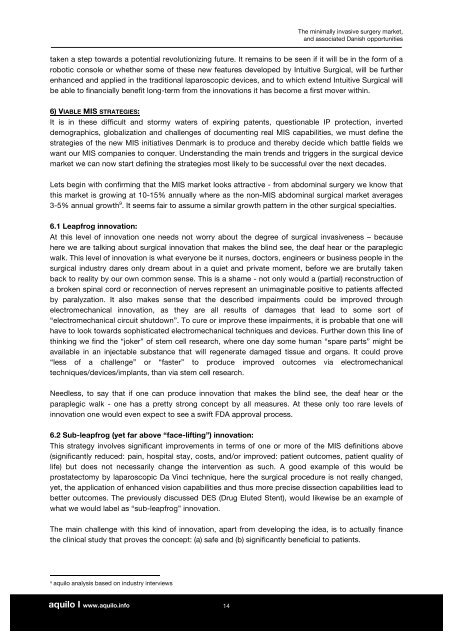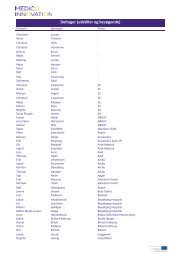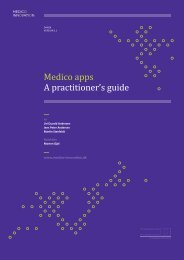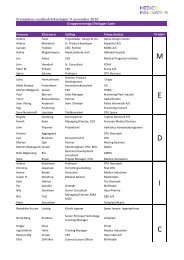The minimally invasive surgery market, and associated Danish ...
The minimally invasive surgery market, and associated Danish ...
The minimally invasive surgery market, and associated Danish ...
You also want an ePaper? Increase the reach of your titles
YUMPU automatically turns print PDFs into web optimized ePapers that Google loves.
aquilo I www.aquilo.info<br />
14<br />
<strong>The</strong> <strong>minimally</strong> <strong>invasive</strong> <strong>surgery</strong> <strong>market</strong>,<br />
<strong>and</strong> <strong>associated</strong> <strong>Danish</strong> opportunities<br />
taken a step towards a potential revolutionizing future. It remains to be seen if it will be in the form of a<br />
robotic console or whether some of these new features developed by Intuitive Surgical, will be further<br />
enhanced <strong>and</strong> applied in the traditional laparoscopic devices, <strong>and</strong> to which extend Intuitive Surgical will<br />
be able to financially benefit long-term from the innovations it has become a first mover within.<br />
6) VIABLE MIS STRATEGIES:<br />
It is in these difficult <strong>and</strong> stormy waters of expiring patents, questionable IP protection, inverted<br />
demographics, globalization <strong>and</strong> challenges of documenting real MIS capabilities, we must define the<br />
strategies of the new MIS initiatives Denmark is to produce <strong>and</strong> thereby decide which battle fields we<br />
want our MIS companies to conquer. Underst<strong>and</strong>ing the main trends <strong>and</strong> triggers in the surgical device<br />
<strong>market</strong> we can now start defining the strategies most likely to be successful over the next decades.<br />
Lets begin with confirming that the MIS <strong>market</strong> looks attractive - from abdominal <strong>surgery</strong> we know that<br />
this <strong>market</strong> is growing at 10-15% annually where as the non-MIS abdominal surgical <strong>market</strong> averages<br />
3-5% annual growth 9 . It seems fair to assume a similar growth pattern in the other surgical specialties.<br />
6.1 Leapfrog innovation:<br />
At this level of innovation one needs not worry about the degree of surgical <strong>invasive</strong>ness – because<br />
here we are talking about surgical innovation that makes the blind see, the deaf hear or the paraplegic<br />
walk. This level of innovation is what everyone be it nurses, doctors, engineers or business people in the<br />
surgical industry dares only dream about in a quiet <strong>and</strong> private moment, before we are brutally taken<br />
back to reality by our own common sense. This is a shame - not only would a (partial) reconstruction of<br />
a broken spinal cord or reconnection of nerves represent an unimaginable positive to patients affected<br />
by paralyzation. It also makes sense that the described impairments could be improved through<br />
electromechanical innovation, as they are all results of damages that lead to some sort of<br />
“electromechanical circuit shutdown”. To cure or improve these impairments, it is probable that one will<br />
have to look towards sophisticated electromechanical techniques <strong>and</strong> devices. Further down this line of<br />
thinking we find the “joker” of stem cell research, where one day some human “spare parts” might be<br />
available in an injectable substance that will regenerate damaged tissue <strong>and</strong> organs. It could prove<br />
“less of a challenge” or “faster” to produce improved outcomes via electromechanical<br />
techniques/devices/implants, than via stem cell research.<br />
Needless, to say that if one can produce innovation that makes the blind see, the deaf hear or the<br />
paraplegic walk - one has a pretty strong concept by all measures. At these only too rare levels of<br />
innovation one would even expect to see a swift FDA approval process.<br />
6.2 Sub-leapfrog (yet far above “face-lifting”) innovation:<br />
This strategy involves significant improvements in terms of one or more of the MIS definitions above<br />
(significantly reduced: pain, hospital stay, costs, <strong>and</strong>/or improved: patient outcomes, patient quality of<br />
life) but does not necessarily change the intervention as such. A good example of this would be<br />
prostatectomy by laparoscopic Da Vinci technique, here the surgical procedure is not really changed,<br />
yet, the application of enhanced vision capabilities <strong>and</strong> thus more precise dissection capabilities lead to<br />
better outcomes. <strong>The</strong> previously discussed DES (Drug Eluted Stent), would likewise be an example of<br />
what we would label as “sub-leapfrog” innovation.<br />
<strong>The</strong> main challenge with this kind of innovation, apart from developing the idea, is to actually finance<br />
the clinical study that proves the concept: (a) safe <strong>and</strong> (b) significantly beneficial to patients.<br />
9 aquilo analysis based on industry interviews







